KEN TOWNLEY - LE QUEROY: BAIT
Le Queroy - Bait and Baiting Tips for the Napoleonic Lake
Hi. These notes are based on nearly 20 years experience of fishing at le Queroy. This is not meant to be the
definitive information as to how to fish the Napoleonic Lake (see photo 1) but I hope you may find this article
useful when planning your own strategy.
PHOTO 1:
The way you apply bait depends on a number of factors not least the type of water you are fishing. The main
lake at Le Queroy is about 5 acres in size and holds about 150 carp. A decent enough stock you would think,
but the carp are quite fussy about what they eat, and they also have their favourite feeding areas. Having said
that, they do respond well to a decent bait correctly applied so bear this in mind. One aspect of fishing Le
Queroy is that it is very popular and everybody will have their own ideas about what constitutes ‘good’ and ‘correctly’!
So bear the following in mind: When you arrive at your the lakeside and choose your
swim, always remember that you will almost certainly be following someone into the swim. I tend to tell
myself that somebody was in her just a few hours ago. How did he fish? Did he catch? Did he over or
under-bait? And so on. I never assume that nobody has fished my chosen swim before I arrived, maybe
as recently as the previous day. I am therefore always cautions about putting bait in when I arrive. Think
Small Spomb rather than Big Spomb, at least to start with. (see photo 2)
PHOTO TWO.
It is always a good idea when fishing a busy lake like le Queroy to keep initial baiting to a minimum.
Remember, it is easy to put bait in, but virtually impossible to take it out again. Only once I have got a feel for the
lake and how it is fishing do I risk putting in more bait. I need to be sure that the carp are a) in my swim and b) eating
bait but once that I am certain they are visiting the swim in good numbers, I tend to bait up quite heavily.
You can get a fair idea of what has been happening at the lake just by asking Dan or any of the
family for that matter. They want you to catch so they will advise you which swims were occupied the previous
week and what was caught and from where and may even be able to tell you what bait has gone in and how
much the previous occupants used. However, nothing beats your own observations so, don’t go at the lake like
a bull at a gate but settle into your session slowly but purposefully. Just let me give you an example:
Back in 2004 we arrived at le Queroy for our customary late autumn session. we were told that the dam
wall swims - our favourites - had been occupied by a succession of visitors for the previous five weeks but the
fishing had been patchy to say the least. I suspected that somewhere down the line somebody had piled the bait in
and this might have spooked the fish. However, so well do we know these swims that we were loath to fish another
one so decided to stay put, keep baiting to a minimum and play the rest by ear. Clearly it would be folly to put in still
more bait on top of the previous occupant’s so we fished hookbaits and stringers only on all three rods for the first
couple of days. We both caught almost immediately but neither of us felt it necessary to pile in more and more bait
but decided to fish for one take at a time. That is to say, fish for a single take and then another, and another and so
on. (More about this later.) At no time did we put more than six freebies on each of our three spots and three of these
freebies were on stringers. That seemed to do the trick and once fish were coming steadily to the bank, and obviously
eating whatever was left and everything we put in afterwards, we decided to bait more heavily. That paid off
for us in spades. (See photo 3)
PHOTO 3.

Type of bait you take to le Queroy is not a critical factor, as long as it is a good food bait.
All the top baits will catch and even though I am a died in the wool Nutrabaits users, I am not so blinded by my faith in
their products as to suggest that baits from Solar, Essential and Mainline will not catch. However, if I have learned one
thing over the many years I have been coming to le Queroy it is that the carp in the Napoleonic Lake adore fishmeals in
preference to all other types of bait ( see photo 4).
PHOTO 4.

We are always confident in our ability to catch at le Queroy but we never assume that the
fishing is going to be easy! The season is usually almost over by the time we arrive for our visit and a lot may
have happened since it opened. Angling pressure at any top quality lake is by definition going to be very
intense and your bait application is important so think before you act.
So let’s assume that you have just arrived at the lake and have set up in a swim that you know had someone in it prior to
your arrival. You are faced with two choices:
1. Try to establish your own bait as quickly as possible by introducing it in quantity or:
2. Fish single high attract hookbaits, perhaps with a PVA mesh parcel attached.
This second option leaves the door open for increasing in the amount of bait you introduce if circumstances allow,
so option two is invariably the one we chose when we first start fishing ( see photo 5). Yes, it is a cautious option but as
pointed out previously what is the point of filling the lake in with your own bait when all you could be doing is chucking
good bait after bad. Think this: the previous occupant of the swim may have completely ruined it by over-baiting.
PHOTO 5.

Don’t expect an instant hit. If after a couple of days you are still fishless then it could be time for a
rethink but to be honest even if we go say, 48 hours without a take, we are not unduly worried. Provided the
bait previously introduced is of decent quality it will break down and loose its flavour after a few days and these
washed out baits may well arouse less suspicion that newly introduced ones.
Let me just give you another example. We arrived at le Queroy for an unusual summer visit and were told by
George, the then owner, that our favourite swim had fished really badly the previous week. Though he could
not be certain, he thought this was due to the over enthusiastic baiting campaign undertaken by
the angler who’d fished the swim before us. The weather had not been ideal, very hot, calm and
oppressive with hardly a breath of wind. Clearly the fish were not going to be charging around all
over the place searching for massive carpets of bait. However, despite George’s advice the guy
who had preceded us decided to fill the lake in with pellet, particles and boilies. The lake fished
really badly as a result and our swim the Dam Wall South - had been one of the poorest of them all.
Undaunted we abandoned any idea of fishing the dam wall area - the swim in questions - an set up
on the point as far from the dam as possible. Sure enough, the fish seemed to be concentrated in
the two bays, avoiding the over-baited zone along the dam wall like the plague! Again we did well with
several forties coming to our nets. (see photo 6).
PHOTO 6.
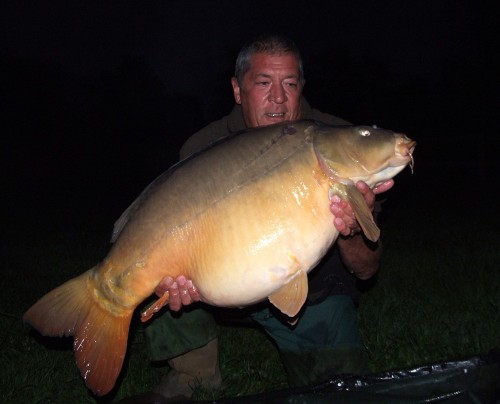
One of the prime reasons why a swim receives too much bait is because the use of a
boat or bait boat is permitted. Anglers tend to over-bait simply because they can. They don’t
need to spend hours with a throwing stick or spod rod. No…It’s out in the boat and dump a
couple of bucket loads over the side followed by kilo after kilo of boilies. It is far too easy to over-
bait when you are in the boat so why not try this little trick?
Place a self-imposed restriction on yourself by only taking a small container of bait into
the boat with you. If, say, you only want to top up the swim with a scoop
or two of pellet and say a dozen boilies then put that amount in the small container and
only take that amount with you when you jump in the boat. That way when the container
is empty the only way you can put more bait in is to return to the bank for more, and by the
time you’ve done that common sense should have prevailed and you’ve realised that enough
is enough. This should be ample for all three rods (see photo 7).
PHOTO 7.
Bait boats pose a more difficult challenge as it is very easy to
fill the hopper with bait and thus go over the top with your baiting. Before sending the bait
boat on its way, look at the amount you have put in the hopper. It is not too late to take some out you know!
Don’t necessarily fish all three rods to specific areas. Yes, by all means keep a couple fishing
on the bait carpet, but we always fish one rod as a rover, casting quite frequently and covering
a wider area, but without putting a lot of bait in. This rod is used to search the lakebed from the
margins out to mid range and again can be baited either with a PVA mesh tube holding crumb,
pellet and mini boilies, a stringer or a light scattering of free offerings.
At all times think of the Napoleonic Lake as a pressured venue, as much if not more pressured
than some of the most popular lakes in the UK. By the late autumn it is quite likely that
they lake will have been fished for anything up to 35-40 consecutive weeks, and not
many lakes in the UK will receive that sort of angling pressure. Some angler will catch
more than others, but even if results are poor for a week or two, the pressure is still there.
The carp know anglers are present so tread softly!
I make no bones about it but if you want to succeed on a pressured lake you simply must
use a good bait. I do not believe that you can achieve the same degree of
competitive, aggressive feeding if you are using a poor quality bait and baits
such as Blue Oyster, Big Fish Mix and Trigga and the like are responsible for
some very impressive catches all over Europe and we certainly wouldn’t think
of using anything else (see photo 8).
PHOTO 8.
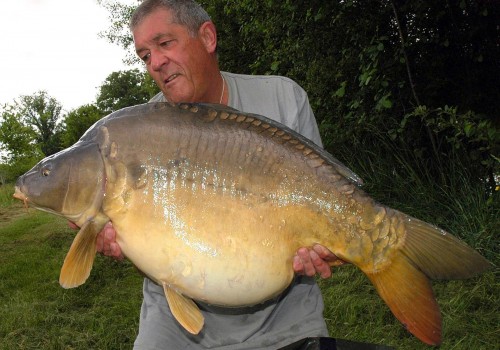
The point is, when you are after the pressured carp you are unlikely to
catch them using poor quality baits. It is a fact that food baits catch carp in numbers
while poor quality baits catch maybe one or two fish (if you are lucky) before they are
ignored or eaten by crayfish. You must offer the carp something that competes with
their normal food as much as possible. Carp instinctively know a good bait from a bad
one and will stop eating poor quality baits. However, offer a food bait and they’ll keep
coming back for more, time after time. There is no point in hampering your chances by
using a bait to which the carp may not like or to which they are indifferent. In the words
of the great man himself (Rod) you have got to “make them ‘ave it”. The better your
bait the more you are likely to catch! That is not a fiction or an piece of dogma without basis. It is a fact!
I guess I am something of a fundamentalist on this subject, possibly even a bit
blinkered, but I know what I know and if you offered me a 25kg bag of poor quality ready
mades or a 1kg bag of a top class food bait such as Trigga I’d take the Trigga every time,
and I’d bet that I’d catch more.
Now from the previous paragraph I don’t want you to think that I am knocking
all shelf life baits. Far from it, in fact. I have seen for myself just how effective
the better quality shelf life boilies can be and will happily use them in quantity
myself. Indeed, I know that some top anglers actually prefer Trigga shelf life to
the ‘real’ thing. There are some superb shelfies available these days as they
have really come of age in the past decade or so. That said,
there are others that I wouldn’t touch with a 10m pole!
Now I know I have warned against over-baiting initially, but cannot catch carp
without using bait! It’s a classic Catch 22 situation. You want to use bait to attract
and then hold carp in your swim but you don’t want to use so much that they spook.
Accordingly you don’t need to set out your stall as if you were going after hundreds
of fish at a time.
I mentioned previously about fishing for one take at a time also know by some
as ‘spot fishing’ This tactic was first suggested to me by my mate Bill Cottam
boss of Nutrabaits and no stranger to huge carp himself. Basically the tactic
is to introduce only enough bait to induce one take. You hopefully hook and
land that one fish, then set out your stall along identical lines to try to tempt
another fish, and then a third, forth and so on.
It is not a tactic that generates loads of action, but it certainly seems to sort out
bigger and thus possibly more cautious, more suspicious carp. And let’s
face it, Bill does know a thing or two about bait…and several more things about
catching carp! (see photo 9)
PHOTO 9.
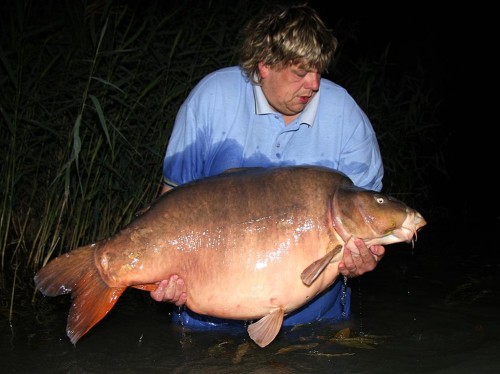
Closely allied to the bait itself is the related topic of how exactly
you apply that bait, and at le Queroy correct bait application can make
a big difference. A simple starting point is to consider the size of your
freebies and the overall size of the bait carpet. I guess it would be fair
to assume that most anglers use baits of between 15mm and 18mm
in size. That in itself can be somewhat limiting so think about the alternatives,
that is to say, bigger or small baits than the norm, or different shaped ones.
For instance, if you were to use either, say, 25mm or 10mm baits that would
be ‘different’ enough to lower the carp’s guard. One approach I have used
with great success her at le Queroy has been to bait up with a mixed blend
of baits, both fresh and shelf life. Small 8mm boilies have often done the trick
for Carole and myself (see photo 10).
PHOTO 10.
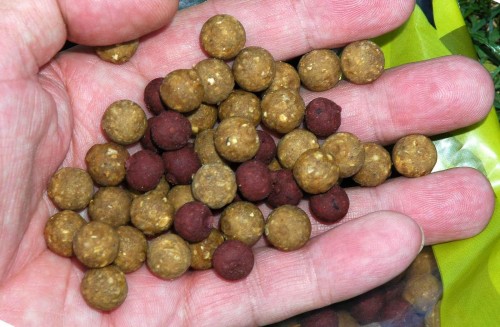
You should also think about the shape of your freebies. The world
and its wife use round baits but on a lake like le Queroy it is not really necessary.
Round baits were made that shape simply because they go further out of a
throwing stick or catapult, but with a lot of the fish that take place here at
le Queroy you will either be fishing at shortish range or will be using the boat
or you bait boat to drop baits. We have been using barrels for the past decade
or more and this tactic has certainly not affected our results in any way (see photo 11).
PHOTO 11.
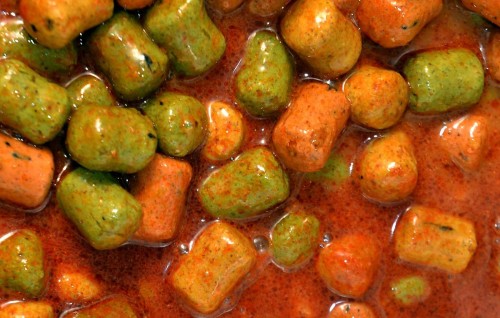
We also use a lot of boilie crumb and paste at the lake. Crumb can be
astonishingly effective for one simple reason. We know that carp can become
obsessed by the shape, size and smell of certain foods and preoccupation on
a food source is a well-known phenomenon. You only have to look at the way tiny
seeds and grains such as hempseed turn them on to know that small can be
beautiful as far as your bait is concerned. However, you also can create heavy
preoccupied feeding by using micro boilie particles, also known as boilie crumb.
Boilie crumb, as its name suggests is a way of using a mass bait
approach but with boiled baits rather than particles. I actually developed this
tactic myself - my one claim to fame in the carp world! - in the mid 80s when I
was looking for a way to get around the natural caution of some very cute UK fish
that simply would not look at standard boiled baits.
You need a degree of foresight if you fancy using crumb, as you’ll almost
certainly have to prepare it at home before you leave. The quickest and easiest way to
make crumb is in a food processor. I use an old one that has been relegated from the
kitchen to the bait cupboard by my wife after I bought her a new more up-to-date
model for Christmas – sneaky! It is ideal for making large quantities of crumb and I
can process 5kg of boilies or boiled sausages in less than 15 minutes. I like to
blend two or three differing baits and smells before crumbing and am not at all
averse to using ready mades. As you can see in the photo this is a combination
of two more shelf life baits from the Nutrabaits range Big Fish Mix and
Cranberry (see photo 12).
PHOTO 12.
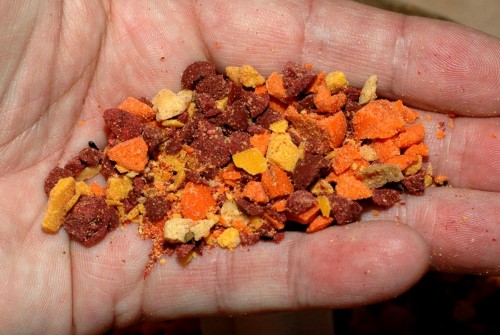
If you prefer to make crumb from your favourite base mix
here’s how to go about it:
· Make up your boilie paste exactly as if you were about to make a mix of boilies.
· Instead of rolling it into balls, form sausage shaped lengths of paste, like you would if
you were using a rolling table.
· Boil the sausages whole.
· Allow the sausages to cool.
· Now feed the sausages through the processor or mincer. Voila! Boilies crumb…
The use of high attract hookbaits is another effective tactic at le Queroy.
I expect you have used this principle of high attract hookbaits yourself in your
carp fishing but the standard boiled bait has it’s limitations as far as attraction
is concerned. OK, you can use bait soaks to impregnate the hookbaits
with flavour and other attractors but this affects the texture and catching life
of the bait. One way of making high attract, high leak-off hookbaits is to
again use the sausage method described above.
· Make up a 3-egg mix but add the same flavour and attractor levels as you would use for a 6-egg mix.
· Roll the paste into sausages.
· Boil the sausages whole.
· Allow them to cool.
· Chop the sausages into your preferred hookbait size.
· This will produce a tube-shaped hookbait with two cut ends.
· As these ends do not have a boiled skin on them they allow water to quickly force
its way into the heart of the hookbait. Once in the bait the lake water releases the
attractors and flavours allowing them to flood out around the hookbait. (see photo 13)
PHOTO 13.
You can draw attention to your hookbait in many different ways and one
way to do so is to use Betaine. This amino acid-like, naturally occurring substance
is one of the best attractors of all time. Not only is it a good idea to incorporate
Betaine in your boilie mix but you should also add it as an exterior dressing
to give an instant whoosh of attraction as soon as the baits hit the lakebed.
Betaine is astonishingly soluble and as it leaks quickly from the outer
dressing and more slowly from within the bait itself it spreads a come hither
smell of food for quite some distance around the bait carpet.
The tried and tested formula for its use is to add 2-4g/500g of mix to the eggs, then
roll out and boil as usual. However, Betaine is at its best when used as
an instant attractor and in this guise it is better to add an exterior coating
of Betaine as well as an interior one. There are two or three ways of doing
this. The first is simply to dip a hookbait in the lake, then pop it straight into
a tub of Betaine. You’ll see how the crystals adhere to the wet boilie and
soon they dissolve as the dampness acts on the attractor, leaving your
hookbait Betaine boosted.
You can also treat an entire batch of bait by sprinkling a teaspoon full or so over
warm baits that have just come out of the boiling pan. The damp and the heat
melt the Betaine almost immediately and as it melts it turns to a liquid, which
is absorbed by the cooling baits. Turn the baits out onto a drying rack as soon
as they come out of the pan then add a sprinkling of Betaine. You’ll see for
yourself how quickly it melts into the outer skin of your bait (see photo 14).
PHOTO 14.
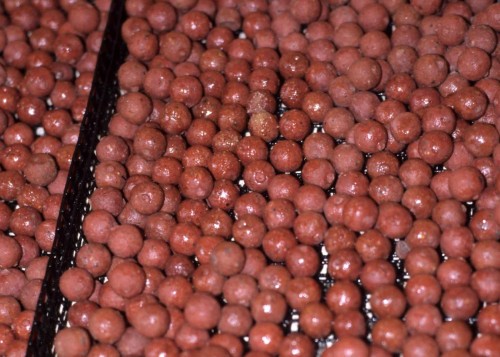
You can add Betaine to just about any liquid you care to mention;
water, neat flavours, sweeteners, liquid foods and so on. You can even use
it to boost pellets, crumb or even particles. It can make a big difference to
any bait soak or hookbait booster or you can make up a hookbait booster to
your own recipe.
Using paste either a a bait, a free offering or as a wrap to put around your boilie
hookbait is a tactic we use a lot and is one that has caught us a huge amount
of carp! First you need to make the paste itself and you can use either eggs or
water (or a combination of the two). Water allows the attraction to leak out
quicker but the paste breaks down more quickly. Eggs on the other hand create
a firmer paste that lasts longer on the lakebed, bear in mind however that the
attraction tends to leak out of the paste more slowly. Place the finished paste in
a polythene bag and freeze it. Take it to the lake in a freezer bag to ensure
it remains fresh for as long as possible. In this way it will last at least a week.
Prior to casting out take a pinch of paste and mould it around the hook bait to
create an immediate source of attraction right at the business end of your
set-up. The carp will invariably home in on the paste-wrapped hookbait,
thanks to the attraction oozing from the paste itself ( see photo 15).
PHOTO 15.
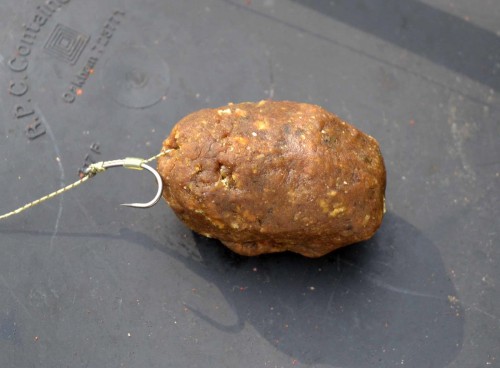
Don’t be afraid to mould that paste around the entire hook bait
and hook shank, as it will soften quite quickly. This allows you a lot of
leeway for pulling back to ensure that the hookbait is in the clear
rather than hooked up on weed or chod. Similarly if you are fishing
a lake where stones and gravel are present you can use the paste
to prevent damage to the hook point by wrapping the entire hook
and the hair in paste (see photo 16).
PHOTO 16.
I hope this article may give you a few ideas as your holiday
at le Queroy draws ever nearer. What I have outlined here is no more
than a general guide to tactics you can use to good effect on the
Napoleonic Lake. All have worked for Carole and myself over the
years and we often look back to bait tactics we were using 15 years
ago and think, that might be well worth another go.
Keep thinking about your baiting approach and try to keep one step ahead
of the carp.They are pretty cute but they are not MENSA candidates!
Have a great time and Le Queroy. If you enjoy yourself half as much as we
do each time we visit, then you’’ really enjoy yourself and few visitors
can stay away once they have been to the lake for the first time. There
are some wonderful prizes awaiting you so the very best of luck to you.
Ken and Carole Townley (Jan 2015)